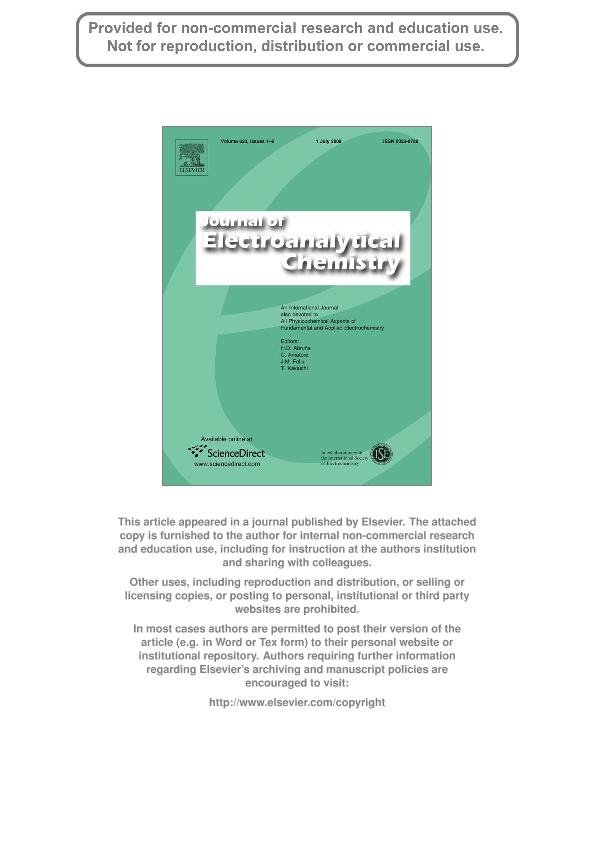Mostrar el registro sencillo del ítem
dc.contributor.author
Linarez Pérez, Omar Ezequiel

dc.contributor.author
Perez, Manuel Alejo

dc.contributor.author
Lopez Teijelo, Manuel

dc.date.available
2019-03-21T18:58:43Z
dc.date.issued
2009-07
dc.identifier.citation
Linarez Pérez, Omar Ezequiel; Perez, Manuel Alejo; Lopez Teijelo, Manuel; Characterization of anodic growth and dissolution of antimony oxide films; Elsevier Science Sa; Journal of Electroanalytical Chemistry; 632; 1-2; 7-2009; 64-71
dc.identifier.issn
1572-6657
dc.identifier.uri
http://hdl.handle.net/11336/72216
dc.description.abstract
The anodic growth, morphology and stability of antimony oxide films grown in buffered phosphate electrolytes has been characterized by electrochemical methods, in situ ellipsometry and atomic force microscopy. The anodic voltammetric behaviour for the growth of antimony oxide films at low potentials can be interpreted as the stepwise electroformation of different antimony species with formation of soluble species up to give Sb2O3. This is followed by the anodic film growth at higher potentials through an ionic conduction mechanism caused by a 'high field', which drives the ionic migration as in typical "valve" metals. Ellipsometric results indicate that anodic films dissolve in the electrolysis media. Anodic Sb2O3 films are anisotropic, with complex refractive indices lower than those of crystalline antimony oxides. This is ascribed to hydration, anions incorporation or lack of crystalline structure in anodic oxides. The electric field strength obtained from the thickness/potential dependence, results 2.25 × 106 V cm-1, which also supports that anodic Sb2O3 growth takes place by an ionic current driven by a high electric field within the oxide film. Morphology of anodic Sb2O3 films obtained by AFM shows that surfaces are smooth and flat and films are pore-free. The grain texture depends on concentration of electrolyte as a consequence of a different chemical dissolution rate. The stability of passive antimony oxide films at open circuit was analyzed by cyclic voltammetry with either constant or increasing anodic switching potentials. The overall growth and dissolution of antimony oxide films is described in terms of the oxide film growth by the high-field migration model coupled with a homogeneous dissolution process. The parameters A and β in the equation i = A exp (βε) that characterize the dependence between current growth and field strength in the high-field growth as well as dissolution current for different conditions are obtained. Dissolution current dependence with electrolyte properties, indicate that antimony oxide dissolution is promoted by phosphate ions and is almost independent of pH. © 2009 Elsevier B.V. All rights reserved.
dc.format
application/pdf
dc.language.iso
eng
dc.publisher
Elsevier Science Sa

dc.rights
info:eu-repo/semantics/openAccess
dc.rights.uri
https://creativecommons.org/licenses/by-nc-sa/2.5/ar/
dc.subject
Antimony Oxide
dc.subject
Ellipsometry
dc.subject
High-Field Growth
dc.subject
Oxide Dissolution
dc.subject
Oxide Growth
dc.subject.classification
Otras Ciencias Químicas

dc.subject.classification
Ciencias Químicas

dc.subject.classification
CIENCIAS NATURALES Y EXACTAS

dc.title
Characterization of anodic growth and dissolution of antimony oxide films
dc.type
info:eu-repo/semantics/article
dc.type
info:ar-repo/semantics/artículo
dc.type
info:eu-repo/semantics/publishedVersion
dc.date.updated
2019-03-18T15:04:51Z
dc.journal.volume
632
dc.journal.number
1-2
dc.journal.pagination
64-71
dc.journal.pais
Países Bajos

dc.journal.ciudad
Amsterdam
dc.description.fil
Fil: Linarez Pérez, Omar Ezequiel. Consejo Nacional de Investigaciones Científicas y Técnicas. Centro Científico Tecnológico Conicet - Córdoba. Instituto de Investigaciones en Físico-química de Córdoba. Universidad Nacional de Córdoba. Facultad de Ciencias Químicas. Instituto de Investigaciones en Físico-química de Córdoba; Argentina. Universidad Nacional de Córdoba. Facultad de Ciencias Químicas. Departamento de Fisicoquímica; Argentina
dc.description.fil
Fil: Perez, Manuel Alejo. Consejo Nacional de Investigaciones Científicas y Técnicas. Centro Científico Tecnológico Conicet - Córdoba. Instituto de Investigaciones en Físico-química de Córdoba. Universidad Nacional de Córdoba. Facultad de Ciencias Químicas. Instituto de Investigaciones en Físico-química de Córdoba; Argentina. Universidad Nacional de Córdoba. Facultad de Ciencias Químicas. Departamento de Fisicoquímica; Argentina
dc.description.fil
Fil: Lopez Teijelo, Manuel. Consejo Nacional de Investigaciones Científicas y Técnicas. Centro Científico Tecnológico Conicet - Córdoba. Instituto de Investigaciones en Físico-química de Córdoba. Universidad Nacional de Córdoba. Facultad de Ciencias Químicas. Instituto de Investigaciones en Físico-química de Córdoba; Argentina. Universidad Nacional de Córdoba. Facultad de Ciencias Químicas. Departamento de Fisicoquímica; Argentina
dc.journal.title
Journal of Electroanalytical Chemistry

dc.relation.alternativeid
info:eu-repo/semantics/altIdentifier/doi/https://dx.doi.org/10.1016/j.jelechem.2009.03.018
dc.relation.alternativeid
info:eu-repo/semantics/altIdentifier/url/https://www.sciencedirect.com/science/article/pii/S0022072809001132
Archivos asociados
